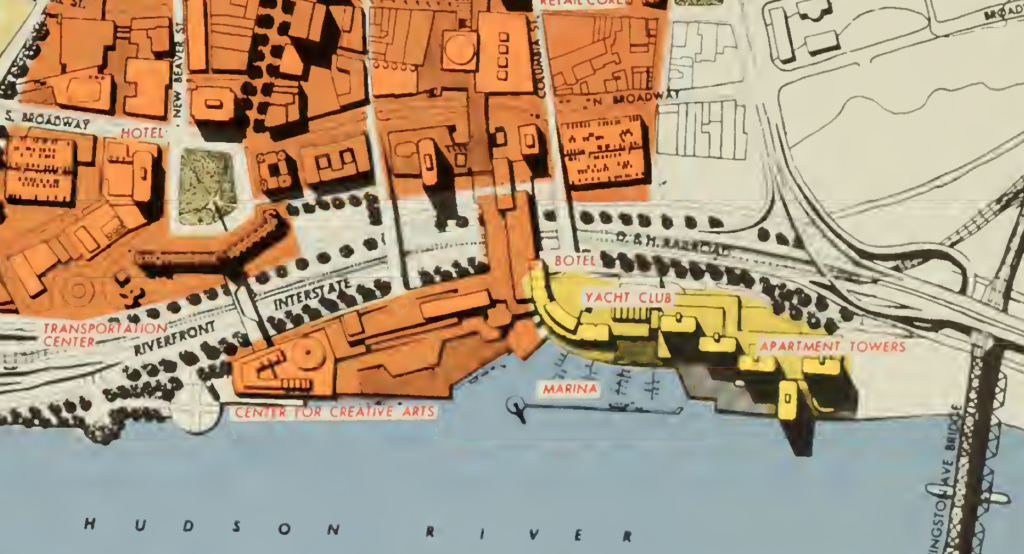So the Temporary State Commission on the Capital City had a whole bunch of recommendations, plans, schemes and dreams, all meant to further the goal of creating a new center of government (then called the South Mall, a little confusing as the word “mall” was then increasingly being applied to those newfangled enclosed shopping centers). The 1963 plan proudly proclaimed that
“By 1980, the central area of Albany, like cities all over the United States, will be almost completely rebuilt, recreating its strength as the center of business, commercial and governmental activities in the Tri-City Area. The South Mall is Albany’s building block around which private and other public investors can plan with confidence.”
But first, let’s lay some asphalt. The plan focused on traffic circulation, with the Riverfront Interstate (I-787) and the Washington Park Arterial (oh yes, there was one planned) providing access to downtown. “A major new boulevard into the downtown is the South Mall Approach, joining the Riverfront Interstate with the South Mall. This landscaped [!] route is connected to a new bridge across the Hudson and to a new route, 9-W, across Rensselaer to the Taconic Parkway. Clinton Avenue will become a major boulevard connecting the Washington Park Arterial to the Riverfront. On the south, Hackett Boulevard, extended into Morton Avenue, will provide access along the south side of the downtown.”
The plan, recognizing that no one enjoys the trudge up State Street hill, looked at downtown as three plateaus: the waterfront, the commercial core around Pearl Street, and the State office area.

The waterfront plan was ambitious: it would reclaim 24 acres of riverfront property on the Albany side, and develop almost 120 acres on the Rensselaer side. The Albany side would become home to a Center for Creative Arts, for high-rise apartments, boating activities and parking facilities. All of this would sit where the Corning Preserve is today; at the time it was railroad yards.
“The Center for Creative Arts will add an important new cultural facility to the downtown area. The apartments, containing about 500 units, will provide a unique opportunity for luxurious, in-town living for those who want the excitement of living on the waterfront close to the commercial heart of the city. The marina, featuring 100 boat slips, a boatel, yacht club and restaurant as well as service area, will bring yachtsmen to the doorstep of downtown.”
If you haven’t noticed a lot of pipe-smoking gents in blazers and captain’s hats wandering around Broadway, that may be because, of all those plans, exactly none of them happened.
“The plan for the Rensselaer side includes some 900 dwelling units, primarily garden apartments and town houses. It also proposes a new civic center, a new shopping center, and a large marina with slips for 200 boats, and large dock and yard facilities.”
Now, that’s the Rensselaer I know.
This went hand-in-hand with the plan for the retail core.

Leave a Reply